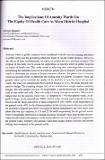| dc.contributor.author | Kaimuri, Maryjoy | |
| dc.date.accessioned | 2019-07-19T07:15:01Z | |
| dc.date.available | 2019-07-19T07:15:01Z | |
| dc.date.issued | 2012-10 | |
| dc.identifier.issn | 2218-7278 | |
| dc.identifier.uri | http://repository.kemu.ac.ke:8080/xmlui/handle/123456789/597 | |
| dc.description | P 451-463 | en_US |
| dc.description.abstract | Amenity wards in public hospitals were established with the aim of retaining specialists in public sector and for generating additional funds to run the health facilities. However, the effects of these establishments on equity of health care have not been assessed. The purpose of this study was to assess the implications of amenity wards in public hospitals on equity of health care. This study aimed at achieving four main objectives to include determining the material resources allocated for patient care in amenity wards and general wards; to determine the number of human resources allocated for patient care in amenity wards and general wards; to determine the waiting time for patients in amenity wards and general wards and to establish the quality of the facilities in amenity wards and general wards. The study was carried out at Meru district hospital in 2010. The study utilized com¬parative design. The sampling designs utilized are stratified and simple random sampling designs. The total sample size was 189 respondents. A questionnaire and a check list were used as data collection tools. Data was analyzed using descriptive statistics. The nurse to patient ratio for the amenity wards was 1:2 compared to 1:9 in the general wards. As regards to drugs, all the respondents (100% (n=l5)) in the amenity wards reported to having received all the drugs prescribed to them compared to 90% (n=99) of the respondents in the general wards. 40% (n=6) of the respondents in the amenity wards who were scheduled for an elective surgical procedure were taken to theatre immediately and 35% (n=5) were taken after one day compared to 1 % and 25 %( n=28) respectively for the general wards. There is inequitable distribution of human resources for health where more health care providers are allocated to the amenity wards to provide care for very few patients compared to the general wards. Similarly, the amenity wards have higher quality facilities and shorter waiting time compared to the general wards. | en_US |
| dc.language.iso | en | en_US |
| dc.publisher | IJPP | en_US |
| dc.relation.ispartofseries | October - December 2012;Vol. 3, Issue 4 | |
| dc.subject | Health equity | en_US |
| dc.subject | Human resources for health | en_US |
| dc.title | The Implications of Amenity Wards On The Equity of Health Care at Meru District Hospital | en_US |
| dc.type | Article | en_US |

